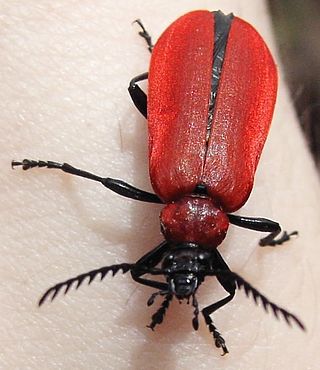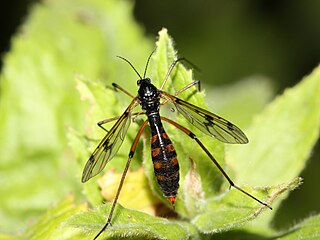
Fire-coloured beetles is the common name for members of the tenebrionoid family Pyrochroidae. The family is found worldwide, and is most diverse at temperate latitudes. Adults measure 2–20 millimetres (0.079–0.787 in); larvae reach 35 millimetres (1.4 in). Larvae of Pyrochroinae are found associated with the bark of dead trees. They are probably mostly fungivorous, although they may become cannibalistic if too crowded.

The Ptychopteridae, phantom crane flies, are a small family of nematocerous Diptera. Superficially similar in appearance to other "tipuloid" families, they lack the ocelli of the Trichoceridae, the five-branched radial vein of the Tanyderidae, and the two anal veins that reach the wing margins of the Tipulidae. They are usually allied with the Tanyderidae based on similarities of the mesonotal suture, this group being called the Ptychopteromorpha.
Chaetopsis quadrifasciata is a species of ulidiid or picture-winged fly in the family Ulidiidae.

Crassispira quadrifasciata is a species of sea snail, a marine gastropod mollusk in the family Pseudomelatomidae.

Serrata quadrifasciata is a species of sea snail, a marine gastropod mollusc in the family Marginellidae, the margin snails.
Spulerina quadrifasciata is a moth of the family Gracillariidae. It is known from Nigeria.

Caryocar brasiliense, known as pequi or souari nut, is an edible fruit popular in some areas of Brazil, especially in Centerwestern Brazil.

Amegilla quadrifasciata, the white-banded digger bee, is a species of bee belonging to the family Apidae subfamily Apinae.

Rivellia is a genus of signal flies. There are at least 140 described species in Rivellia.
Amphicnaeia is a genus of beetles in the family Cerambycidae, containing the following species:

Melipona quadrifasciata is a species of eusocial, stingless bee of the order Hymenoptera. It is native to the southeastern coastal states of Brazil, where it is more commonly known as mandaçaia, which means "beautiful guard," as there is always a bee at the narrow entrance of the nest. M. quadrifasciata constructs mud hives in the hollows of trees to create thin passages that only allow one bee to pass at a time. Because they are stingless bees, M. quadrifasciata is often used as pollinators in greenhouses, outperforming honey bees in efficiency and leading to overall larger yields of fruits that were heavier, larger, and contained more seeds.
Aristobia quadrifasciata is a species of beetle in the family Cerambycidae. It was described by Per Olof Christopher Aurivillius in 1916 and is known from Sumatra and Malaysia.

Ptychoptera albimana is a species of fly in the family Ptychopteridae. It can be found throughout the Palearctic but commonly found throughout Britain.
Ptychoptera townesi is a species of phantom crane flies in the family Ptychopteridae.

Ptychoptera is a genus of phantom crane flies in the family Ptychopteridae. There are at least 70 described species in Ptychoptera.
Rivellia quadrifasciata, the soybean nodule fly, is a species of signal flies. Larvae are known to feed on Glycine max, Phaseolus limensi, Vigna unguiculata, and Desmodium plants.
Ptychoptera sculleni is a species of phantom crane flies in the family Ptychopteridae. It can be found in the far western portion of the United States, namely the states of California, Oregon, and Washington.
Gibberula quadrifasciata is a species of sea snail, a marine gastropod mollusk, in the family Cystiscidae.
Urophora doganlari is a species of tephritid or fruit flies in the genus Urophora of the family Tephritidae.

Toumeyella is a genus of tortoise scales in the subfamily Myzolecaniinae of the true bug family Coccidae.











